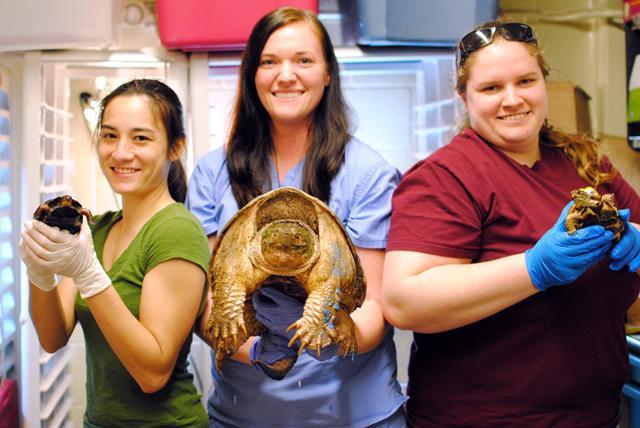
© NCSU Student Media 2012
Turtle Rescue Team captain, Caitlin Cavanaugh, stands with co-presidents Anne Meyer and Kahlina Frey, all third-year College of Veterinary Medicine students. The Turtle Rescue Team is dedicated to treating injured wild turtles, such as the two eastern box turtles and snapping turtle above. Photo by Natalie Claunch
Gregory Lewbart, professor of aquatic animal medicine, has always had a special place in his heart for turtles. So naturally when a friend of his brought in an injured wild turtle, he treated it. When the news spread and 10 more turtles followed that one, he did his best to treat them, too. However, he realized a solution had to be found when he started receiving about 50 wild turtles a year.
“I was starting to get a little overwhelmed with turtles,” Lewbart said.
So he got students involved with his cause and started what is now known as the Turtle Rescue Team.
“We work to fix the turtles, then we send them to rehab, and then the ultimate goal is to release back into their natural habitat,” Kahlina Frey, a doctorate of veterinary medicine and co-president of the Turtle Rescue Team, said.
The team has grown tremendously; they now receive about 200 turtles per season. Though many of the turtles are found because they have been hit by cars, the work done on them varies dramatically. Team members have even performed dental work on turtles after their mouths had been injured so they could eat properly.
”We do definitely try to contribute to reptile medicine, as far as trying new techniques to see what works,” Anne Meyer, a doctorate of veterinary medicine and co-president of the Turtle Rescue Team, said. “We’ve tried several different fracture repair techniques, because a lot of times turtles will come in with fractured limbs, and it poses a special problem when it’s small turtles to try to fix the bone.”
Usually turtles with broken legs need amputations, the turtle team has been working on new methods of bone repair and recently tested it on a box turtle named Gimpy Steve.
“They developed an epoxy splint or brace for the outside of the leg so the turtle wouldn’t pull it into the shell…That leg did heal up, and he was able to use his leg and was eventually released,” Lewbart said.
The team primarily treats native North Carolina turtles, but they will also treat invasive species or other reptiles or amphibians if they are injured. For example, they’ve treated a black rat snake that had eaten a plastic chicken egg and a bullfrog named Charlie who had a broken leg.
”We also do a lot of community outreach stuff-we go to different events and try to work with the community and tell them about [the] turtle team,” Frey said.
The team’s mission is exposure, not just rescue work. Not only do people have to know to call if they find an injured turtle, one of the steps in turtle recovery is rehab, where individual volunteers take a turtle that has been treated home with them until it can fully heal.
“We work with the person who finds them to see if they are interested in rehabbing and releasing so we can keep them involved in that whole process,” Frey said.
The doctors usually try to name groups of turtles by themes; this summer they’ve had a beer theme, a Harry Potter theme and a Spanish theme.
Frey became particularly attached to a turtle named Hognose , so dubbed because one of his eyes and the end of his nose had to be removed.
“He was touch-and-go for a while,” Frey said. “His prognosis was very guarded, but we ended up nursing him back to health…and we released him at the end of the season. He had some spunk to him. He would hiss at you a lot. He was feisty; he was a feisty little fighter.”
The Turtle Rescue Team is open to anyone who wants to get involved. Pre-vet undergraduate students can practice working with reptiles there, or volunteers can house a turtle who is in rehab.
“You get a lot of medical practice, on how to deal with a case and go through a case and what treatments to do and tests to run,” Frey said. “It’s a really good opportunity if you are ever thinking of doing something in the medical field, or if you just like turtles.”